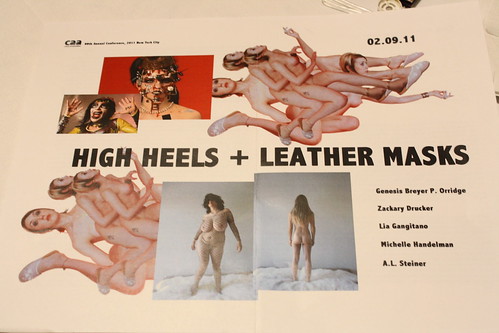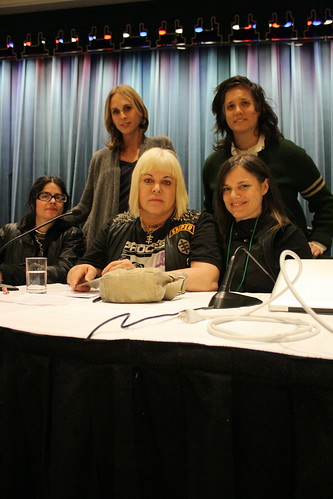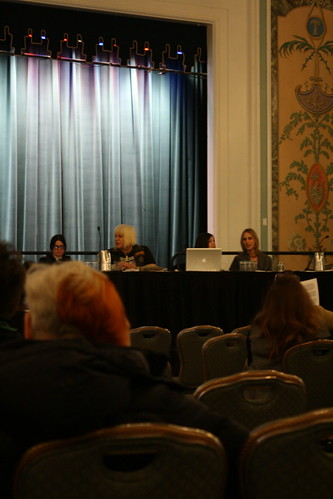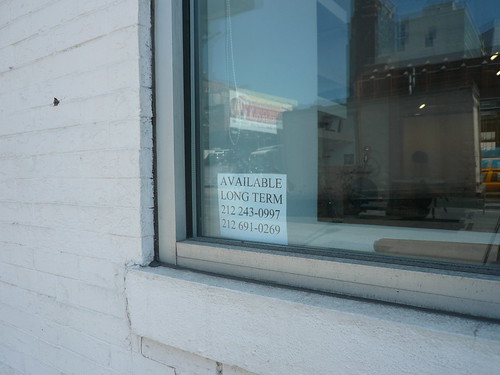Category Archives: Sessions
Making a Living as an Artist (With or Without a Dealer) – part 1
Image Via
Today’s well attended ARTspace panel, “Making a Living as an Artist: With or Without a Dealer,” was lively and informative as all get-out. Organized and chaired by artist Sharon Louden, it brought to bear the expertise of a number of New York City’s finest art mavens: the artist and writer Sharon Butler, whose well appointed blog Two Coats of Paint will be familiar to many readers here; artist, former gallery director, curator and current Director of the Elizabeth Foundation for the Arts Studio Program Bill Carroll; artist, curator and current Dean of The New York Academy of Art Peter Drake; and New York dealer, inveterate blogger and author of How to Start and Run a Commercial Art Gallery Ed Winkleman.
[Full disclosure: I am represented by Winkleman Gallery; Sharon Butler, a fellow painter, is the author of one of my favorite art blogs, where she recently wrote a thoughtful review of my last show; Sharon Louden -- well, Sharon is every artist's hero (she's been mine for quite some time); and Bill Carroll and Peter Drake aren't exactly chopped liver! Basically, there was no way I was going to miss this panel...]
Here is an encapsulation of the discussion (paraphrased) — I’ve divided it up into several posts:
Sharon Louden: Everyone here on the panel wears a number of different hats; some of them have been through many dips in the economy before. My interest in gathering you together here is to explore how artists themselves have the power to weather these dips, and the kinds of partnerships that might help that process.
Bill Carroll: It is very difficult to make a living as an artist. You need a fallback, as it really is like a lottery. During a downturn, having a gallery may even be irrelevent if they can’t sell your work. Interestingly, more galleries closed during the 90s downturn than in this recent one. Back then, the mid-career artists were hit hardest — that market completely died. One of our artists [at Charles Cowles Gallery] who was a sculptor turned entirely to public commissions and it changed his career in a very positive way. He still makes sculpture, but public commissions have since become an important part of what he does.
Ed Winkleman: I have two collectors who’ve been collecting art for 35 years. When the downturn hit in 2008 they said: we just don’t know the real price of anything right now, and we’re going to hold off buying until we can determine which prices have been inflated. So, one thing artists can do in response to such a situation is to put out a new body of work with lower prices — if you are a painter, you might create a new series of drawings, for example — and get those out and into the market, rather than having to lower the prices of your existing body of work.
Sharon Butler: As an artist I want to remind people — I think many people forget — that artists have a lot of skills. In the last downturn, I decided to go to graduate school. I managed to get a scholarship and a stipend, and I treated it like a residency.
Peter Drake: If you’re in this room you are already proactive — artists and creative people taking control of their lives. I think of Jeffrey Lew and Gordon Matta-Clark and what they did when they established 112 Green Street.…
Image Via
Sharon L: Artists come to me and they ask: how do you get a dealer? But is having a dealer the answer? Is it key? Why is that perceived need there?
Sharon B: Having a dealer is only part of the puzzle of being an artist. Don’t put all your eggs in that basket. Even with gallery representation, you have to do things yourself. The reality is, THERE AREN’T ENOUGH GALLERIES to accommodate all the artists [and, it's intimated, not enough collectors - not enough demand].
Bill: You are ALWAYS responsible for your own career. A smaller gallery especially cannot be working on your career all the time. Most of the people I now who make a living off their work have several galleries — you need to look for galleries in other cities outside New York City.
Ed: There’s a sense you get, looking at submissions, that many artists think getting a gallery is an end-goal. Also, artists need to think in terms of working with a team — with their gallery. Especially during a downturn.
Bill: Many artists come into a gallery and think they’ve found parents (laughter).
Peter: There are many different “art worlds’… in any case it really is a partnership you enter into with your dealer. You have to adjust to make sure your partnership stays whole. You also have to help them extend their reach. To reciprocate, many dealers will ask their artists to curate shows.
To be continued… Part Two
The Art of Pranks
“The Art of Pranks” (Thursday 9:30-Noon)
It was standing room only for this session and the crowd was as excited as I have seen so far at the conference. Beauvais Lyons chaired this panel that featured Sarah Archino, Albert J. Godycki, Hannah Higgins and Simon Anderson, Clark Stoeckley with Andy Bichlbaum as Discussant. Lyons began by showing examples of work that could be labeled as a “prank.” He started with Marcel Duchamp, an easy choice, right? Lyons included images of various artists, office pranks gone awry and performance artists of the 1960’s and 70’s. He also included an image of Damien Hirst. The image had barely appeared on the screen when boos and hisses emitted from the overflowing crowd. Man, do people hate Hirst. Almost, if not more, than Jeff Koons. I find it interesting that some would put Hirst in the same category with people that would cover a fellow co-workers office in aluminum foil or post-it notes. But, maybe, that is just me.
Besides the distaste for Hirst, the idea of “Prank Theory” is an intriguing topic I would like to research further. Some of the points discussed were prank in relation to parody, the ethics of deception and the relationship of art and humor. I think further examination of prank theory could work as a discussion topic in one of my seminar classes. It makes for interesting presentations, that is for sure. Higgins and Anderson had participants throughout the crowd stand and yell, interrupting the presentation. Higgins would take time from her talk to fill the water glass of someone in the crowd, while someone wearing a Joseph Beuys mask stood holding and petting a dead hare.
Clark Stoeckley, dressed as a NYPD Lieutenant, provided an overview of graffiti artists ruining cities and performance artists that are disrupting and manipulating the media. A few of the highlights of Stoeckley’s presentation were images of Improv Everywhere’s annual The No Pants Subway Ride in New York City and the work of Steve Lambert. Lambert is my favorite new artist.
There were many more highlights of this session and I look forward to thinking about them in more detail later. But, as I sat on the floor, I just couldn’t help but to wonder if the same Hirst hatred would continue tomorrow during the session “Prophet/Profit: The Famous Case of Damien Hirst.” I guess I know what I will be doing between 9:30 and Noon.
“Global Art Histories/ Multiple Modernities”
The Centennial Session on “Global Art Histories/ Multiple Modernities” (Thursday, Feb. 10, 9:30am-Noon) is undoubtedly the liveliest panel I’ve seen thus far at the conference. C0-chaired by Leslie King-Hammond and Sarah Lewis, these panelists were as smitten with each others’ work as they were enamored of the topic – or should I say with the idea that this topic represented for them. While there were open disagreements among the panelists themselves as to the nature of their involvement with the global art scene, the entire event was punctuated by a lot of good-natured ribbing and poorly stifled guffaws.
As Dr. King-Hammond admitted in her opening remarks, she was not immediately jazzed to take the proscribed directive of hosting a “panel on diversity.” In fact, this former president of the CAA made it clear that she did not – and does not – wish to call this a diversity seminar (though it may still be listed that way) because, frankly, it’s a struggle which has become difficult to the point of exasperation in recent years. Using the Museum of Arts and Design’s current exhibition (“The Global Africa Project”) as a jump-off point, she and her fellow panelists invited those of us in the audience to make up our own minds as to the importance, depth or shallowness, and continued relevancy of such terms as “diversity” and “multiculturalism.” Furthermore, they compelled us to question the apparent triumphs and shortcomings of any “multiple, pluralistic, and cultural-comparative” mode of art production in today’s global modernity.
Sarah Lewis presented a phenomenal talk concerning 19th-century photographs of the so-called “Circassian beauties,” women of the Northern Caucasus who formed part of Barnum’s postbellum museum exhibition and were routinely paraded as exemplars of ideal white beauty. It was through images of these women that Lewis was able to illustrate many of the ways in which the permeability of race and color (as it was imagined in the 19th century) continues to plague racial identity and scholarship even today. Nonetheless, Lewis encourages us that a continued close reading of objects of art, no matter how troublesome they may be, eventually yields a greater understanding of ourselves and of people who may be located in faraway places and centuries past.
With her very first breath, Mina Cheon heartily disagreed with King-Hammond’s opening remarks by claiming, “Well, I’m not done fighting for diversity!” She then proceeded to layout a well-reasoned and sardonic rant against the stagnant institutionalization of art education in university located across the globe today. Citing her dual role as a Korean artist and an American educator, Cheon directly contradicted Lewis by asserting that works of art are resolutely not objects, but rather are more appropriately considered relations between geopolitical negotiations. Yet, much to her dismay, the full imperative and latent power of these relational objects are routinely stifled by the rote academicism that she it today charged to embody. The stagnation of the “art institution,” she claims, allows it to “gain more power the less it does.” Her thinly veiled diatribe against such institutions as that which employs her or the CAA itself was certainly a call to arms, but one whose form and trajectory remain indeterminate.
Continuing the trend, Lowery Sims began the next installment in the session by claiming outright, “I am a victim of diversity fatigue . . . [and] I just don’t give a damn anymore!” Such a statement which was met with uproarious laughter and characterized much of the panelists lighthearted rancor concerning the current state of things. At times humorous and witty, Sims’ talk meandered through the many motivations and themes of the “Global Africa Project” mentioned earlier. Claiming that the title was supposed to be “a prosaic placeholder for a sexier title,” she and the other organizers of the exhibit became too immersed in teasing out the fascinating themes of the exhibition to think anymore about it. Her dialectic of post-colonial thought versus our “Afro-Presumptive” tradition was fantastic, and her temporal/ pro-active approach to the curatorial practice was enlightening.
Finally Edward Sullivan’s talk began with even more scathing jests directed (again) toward the institutionalization of art and the often frustrating tedium associated with conferences such as this. But I think he reflected the sentiment of the entire audience when he said with a smile, “But this was fun! You all have redeemed my love for this kind of thing!” His thoughtful and at times affable run-down of his favorite artists working today was a real treat and remained refreshingly upbeat. Afterward, Paul Chaat Smith of the National Museum of the American Indian kept the spirit alive by joking about “the latest news on Indians” and how their situation may or may not resemble that of Egyptians today. He spoke of the idea and construction of the NMAI in 2004 and of how politics are often prohibitively expensive for Indians. Indians, he reasons, participate in art-making rather than policy construction. “Art is cheap and its part of our brand,” he quipped. “We’re like the supermodels of the ethnic world,” what with the wild get-ups and feathered headdresses with which Native Americans are so often portrayed in the media. All in all, it was a fantastic talk.
High Heels and Leather Masks: The Questions at Hand

High Heels and Leather Masks - Session Program. February 9, 2011.
How do you create language around a subject that inherently defies single definitions? Or better yet, how do you speak about something that usually elicits grunts and groans and shrieks from your audience? How can an image have so much power to the point where people call for your shows to be shut down in order to “keep your work from ‘polluting’ the minds of the public”?
These are the questions that Michelle Handelman posed to the audience, speaking artists and curators during the session High Heels and Leather Masks: When Fetish Becomes Art and Art Becomes Life just after introducing Lia Gangitano, Genesis Breyer P. Orridge, Zackary Drucker and A.L. Steiner. While this session appeared to be shocking to some audience members (a woman walked out when they showed a part from A.L. Steiner’s Community Action Center), the panelists insisted that this wasn’t the intention. Works like Community Action Center are meant to be viewed as celebratory works that use the body as medium and make an effort to redefine and relocate our understanding of ourselves and where those understandings are stemmed from. No one ever said that breaking habits and tearing down the walls of our conditioned understandings would be easy, and these artists and curator definitely prove that beautifully with the bodies of work and exhibitions showcased during the session.
As I have more time to reflect on this session, I will add to my recount. Until then, enjoy some photos from the discussion.

Session panelists: (front) Lia Gangitano, Genesis Breyer P. Orridge, Michelle Handelman, (back) Zachary Drucker and A.L. Steiner. Feb. 9, 2011. (Image Credit: Tempestt Hazel)

The audience waits for the session to start as panelists talk among each other. February 9, 2011. (Image Credit: Tempestt Hazel)
Agenda for the Day
I am such a great blogger. Yesterday, I posted my second entry to the CAA Conference blog. It was a great one. But, I noticed this morning I hit delete rather than post. Oops. I hope I do not get fired on the second day. Oh well.
Here is a list of highlights from the first day.
- A discussion on who at CAA is wearing the blackest black. (Just for the record, I used Rit Dye on all my blacks Monday in preparation for the blackest black contest.)
- The NBA Ballerz 2010 Poetry reading held at the Tea Lounge in Brooklyn. What is nerdier than attending a CAA conference? Going to a poetry reading, of course. This poetry reading was special as the poems were not about longing, death, or your abusive father. None of the poets wore berets. The poems were about the NBA and special NBA players. There was a lot of hating on Michael Jordan and Lebron James. There was even a poem about one of my favorite player, Marc Gasol Center for the Memphis Grizzlies. (Just for the record, besides my wife, my art, and my two kitties, the NBA, specifically the Memphis Grizzlies, is my favorite thing in the world.)
- Discussing with Adrian Duran why the CAA may want to rethink its current format or risk losing its members and effectiveness as a conference. It was a great and interesting conversation and I look forward to posting that interview later in the week and seeing your comments.
I did attend several sessions yesterday and may mention those in future posts. But I am off to attend “The Art of Pranks.”



